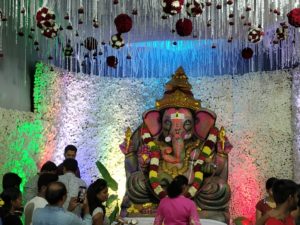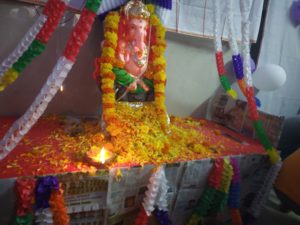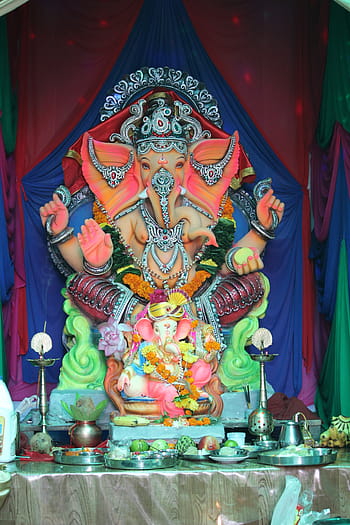The Importance of Lord Ganesha
The word Ganesha is composed of two words: Gana meaning people, and Isha meaning god, therefore the God of People. He is also known as Ganapati meaning leader of people, and Gajanana meaning one with an elephant head.
According to the legend, once when the goddess Parvati was taking bath, she created Ganesha and asked him to guard the entrance and not allow anyone to come. Following her order, Ganesha refused to allow even god Shiva, Parvati’s husband, to enter. Angered by this, Lord Shiva attacked Ganesha and cut off his head. When Parvati found out that Shiva had killed Ganesha, she was overcome with grief. So to appease her, Shiva attached an elephant’s head to the body and brought Ganesha back to life. There are many other legends as to how Ganesha came to be. However, in all of them, he is the son of Parvati and Shiva either by blood or by adoption.
True to the name, Lord Ganesha is by far the most popular and most commonly worshiped deity among Hindus. He is invoked by Hindus of all denominations and is worshiped at religious as well as secular occasions. He is not only worshiped on festivals devoted to him, but also at the beginning of all prayers, all-important personal and business undertakings, and all religious ceremonies devoted to other gods and goddesses.
His popularity as the first deity to be worshiped at virtually all occasions stems from the belief that he is a God of good beginnings for all important occasions and ventures. He is considered the Lord of Obstacles: while he removes obstacles from the path of those who deserve his help, he is also known to place obstacles in the way of those who need a lesson in humility. He is also considered the lord of letters and learning, knowledge, wisdom, intelligence and intellect. He is associated with the concepts of Buddhi (intellect), Siddhi (spiritual power), and Riddhi (prosperity), often personified as three goddesses and Ganesha’s wives. He is often worshiped along with Sarasvati, goddess of knowledge, and Laxmi, goddess of wealth and prosperity. People believe that Ganesha’s blessings will grant them intelligence, success, material and spiritual prosperity, and protection from all adversities.
The Importance of Ganesh Puja in Diwali Celebrations
Diwali is the most important and commonly celebrated festival of Hindus in India and around the world. Diwali, derived from the Sanskrit word Dipawali, literally means a row of lamps. It is a celebration of the blessings of all good things we are fortunate to have and the expression of hope that with effort and determination all the difficulties and obstacles of life will be overcome. 
In its most elaborate and inclusive version, Diwali extends over a period of six specific consecutive days of Hindu lunar calendars. However, the fourth day of Diwali, which falls on the last no moon day of the Ashwin month in the Indian National (Hindu Lunisolar) calendar, is by far the most important and universally celebrated day of the festival across all regions. As such, it is referred to both as just Diwali Day or as Laxmi Pujan day and is devoted to Laxmi, the goddess of wealth and prosperity.
Even though this or none of the other Diwali days is designated specifically to Ganesha, considering the core theme of Diwali celebrations, it is customary that the celebration of its most important Laxmi Pujan day begins first with Ganesh Puja immediately followed by Laxmi Puja. In fact, the two Pujas are so inseparable that the worship is often referred to as the Ganesh Laxmi Pujan even though the day is referred to as Laxmi Pujan day.
The Rituals of Ganesh Puja
The word Pujana (worship) means reverence, honor, adoration, expression of gratitude, complete submission, appeasement, and imploration for a blessing. Puja is one aspect of worship, and normally refers to the religious ritual ceremony constituting the worldly aspect of worship, often accompanied by presentation of material offerings, personal services, and spiritual devotion to the deities. The core idea is to surrender to the deities, present gifts or offerings, and pray for their blessings for success in important ventures. Puja is done on a variety of occasions and in various settings: in homes and temples, at major festivals, and at other places where new ventures are located.
The specific rituals involved in a Puja can vary from very simple needing no preparations and taking only a few seconds, to very intricate, involving long periods of preparations, and ceremonies extending over many days or even months. Whether simple or elaborate, a Puja must be performed in immaculately clean and holy settings. Therefore, on a Puja day, the place of worship is thoroughly cleaned. All members of the family get up early, finish their bath, and wear fresh clothing. The person performing the Puja wears special clothes reserved for the holy occasion and only then begins performing the rituals.

In the Puja rituals the deity Ganesha is treated as a real person and a guest visiting the home at the host’s request after a long journey. The various components of a comprehensive Puja and their meanings are as following:
Awahana (invocation): to invite the deity
Asana (seat): to offer the deity a seat
Swagata (welcome): to greet and inquire the deity’s wellbeing
Padya Puja (washing of the deity’s feet): as the expression of utmost respect
Arghya (offering of water): to freshen up
Achamana (offering of water): to drink
Madhuparka (offering of honey or a honey-water drink): as an energy booster
Snana or abhisekha (bath): offering of water for bathing
Vastra (clothing): Offering of fresh clothing
Anulepana or Gandha (perfumes and ointments): For feeling fresh after bath
Puspa (flowers): offering of loose flowers or a garland
Dhupa (incense): Offering of a burning incense
Deepa (lamp): lighting the lamp
Arati (lamp ritual): the process of holding the lamp in front of the deity
Naivedya or Prasada (any fruit, sweets, or special food items): First offered to the deity (Naivedya), and later, taken by the worshipers as blessings of the deity (Prasada)
Namaskara or Pranam (Folding of hands, bowing, or complete prostration): to symbolize complete submission, surrender, and homage
Visarjana or Udvasana (farewell): Departing wishes to the deity
Rakta chandana (red sandalwood) paste, red flowers, Durva (blades of a special grass, Modaka (a sweet steamed dumpling), Laddus (sweet balls), and other sweets, are often specifically included in the Ganesha Puja due to the belief that Ganesha has a special liking for them.
In Hindu homes, a small family shrine is set up either in a separate room, or on an altar located in a private room in the interior of the house. The shrine has Murtis (idols) or pictures of various deities, some popular and common in most homes, while others unique to each family’s tradition. Lord Ganesha and goddess Laxmi being the most popular deities among Hindus, their idols are invariably in most Hindu homes.
Ganesh Puja is performed either by the lady of the house or an elder person of the family in the evening of the Diwali day, with some simple offerings of light, water, incense, flowers, and fruit, and incantation of a few prayers. Often a specially designed and decorated copper, brass, or silver plate is used to keep the items needed for such Puja: a Deepa (oil lamp), Saffron paste, Haldi (turmeric), Kumkum (holy red color powder), camphor, metal cup for water, spoon, etc. Fresh flowers and fruit available on the day complete the list.






